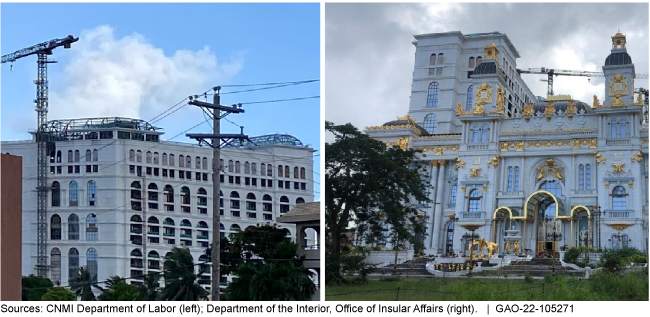Commonwealth of the Northern Mariana Islands: Recent Workforce Trends and Wage Distribution
Fast Facts
The Commonwealth of the Northern Mariana Islands is a U.S territory in the Pacific. Its workforce has changed substantially since 2000, and its tourism-based economy was hit hard by COVID-19. We reviewed trends in its workforce and wage distribution and found:
- The number of foreign workers fell 73% from 2001-2020
- U.S. workers were about half of the workforce in 2016 but 59% in 2020, in part due to a 2019 law that allowed foreign workers with employment visas to become long-term U.S. residents
- An annual study showed the number of workers earning less than $8 an hour declined 68% from 2019-2021 due to COVID-19 and lower study participation
Closed and Unfinished Commonwealth of the Northern Mariana Islands Casino and Resort

Highlights
What GAO Found
The federal government controls immigration for the Commonwealth of the Northern Mariana Islands (CNMI), including administration of a foreign worker permit program that is specific to the CNMI. Under this program, the ratio of U.S. to foreign workers in the CNMI remained close to 50 percent from 2016 through 2018. U.S. workers increased to 56 percent in 2019 and 59 percent in 2020, partly because the CNMI government identified persons lawfully admitted for permanent residence (LPRs) in the total of U.S. workers. The size of the overall workforce grew from 2016 to 2017 before contracting by about 2,000 workers in 2018, and dropped by more than 5,000 workers from 2016 to 2020. The Department of Homeland Security approved about 11,600 CNMI-Only Transitional Worker (CW-1) foreign worker permits for 2019 and about 5,400 for 2021, dropping from a high of 13,685 in fiscal year 2017.
Employed Workers in the Commonwealth of the Northern Mariana Islands (CNMI), Calendar Years 2016–2020

Notes: For 2016 to 2018, U.S. workers include U.S. citizens and nationals, and citizens of the FAS—the Federated States of Micronesia, the Republic of the Marshall Islands, and the Republic of Palau. Foreign workers include all other workers, potentially including LPRs because the data provided to GAO did not identify LPR workers. For 2019 and 2020, U.S. workers include LPRs identified by the CNMI. Foreign workers include all other workers who are not U.S. workers.
According to the Prevailing Wage Study (PWS), an annual study of employers in the CNMI, the reported number of employees earning less than $8 per hour declined by 68 percent from 2019 to 2021. The decline is largely due to economic hardship during the COVID-19 pandemic and to lower study participation by private businesses. Because of the decline in the number of low-wage workers, 94 percent of CNMI workers in the PWS currently earn above the federal minimum wage of $7.25 per hour, an increase from 73 percent in 2019. GAO also illustrated how various hypothetical minimum wage levels would affect workers. For example, at current wage levels, a minimum wage increase to $10 per hour could directly affect 50 percent of workers included in the PWS.
Why GAO Did This Study
The Consolidated Natural Resources Act of 2008, which amended the 1976 Covenant between the U.S. and the CNMI, established federal control of CNMI immigration beginning in 2009. Under the act, the Department of Homeland Security began implementing a foreign worker permit program that was specific to the CNMI. The Northern Mariana Islands U.S. Workforce Act of 2018 extended the CW-1 program for 10 additional years, through the end of 2029. In addition, as required by a 2007 law, the CNMI minimum wage was increased over time to match the current federal minimum wage of $7.25 by 2018.
The Northern Mariana Islands U.S. Workforce Act of 2018 included a provision for GAO to biennially examine the ratio of United States workers to other workers in the CNMI over the 5 previous calendar years. GAO was also asked to examine the structure of wages for workers in the CNMI. This report examines (1) recent trends in composition of the CNMI workforce, including the ratio of U.S. workers to foreign workers in the CNMI during the previous 5 calendar years, and (2) the distribution of wages for workers in the CNMI from 2019 through 2021. GAO analyzed CNMI government and U.S. agency data and prior GAO reports, and interviewed officials from the CNMI government and the U.S. Departments of Commerce, Homeland Security, and the Interior.
For more information, contact Latesha Love at (202) 512-4409 or LoveL@gao.gov.
